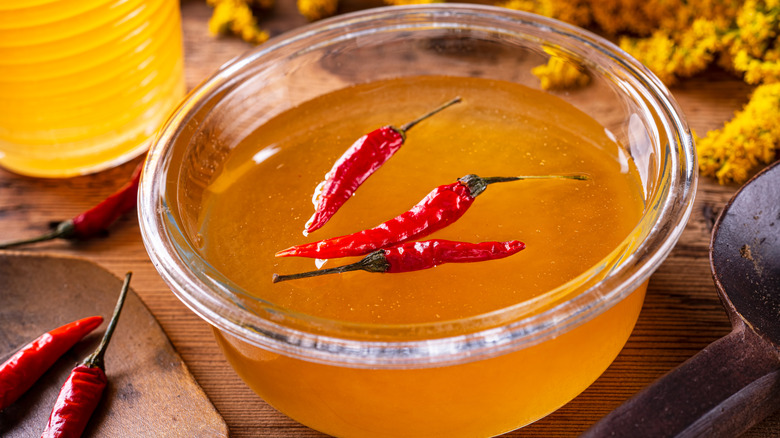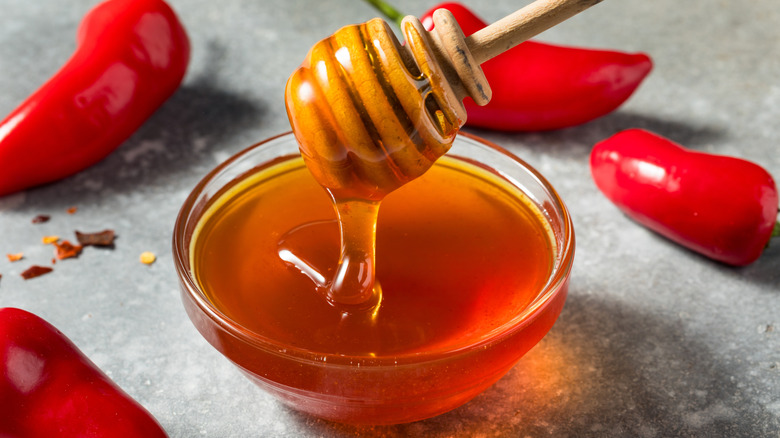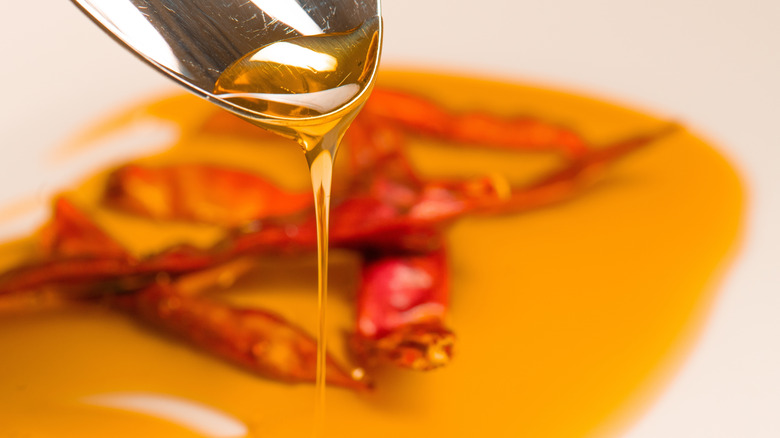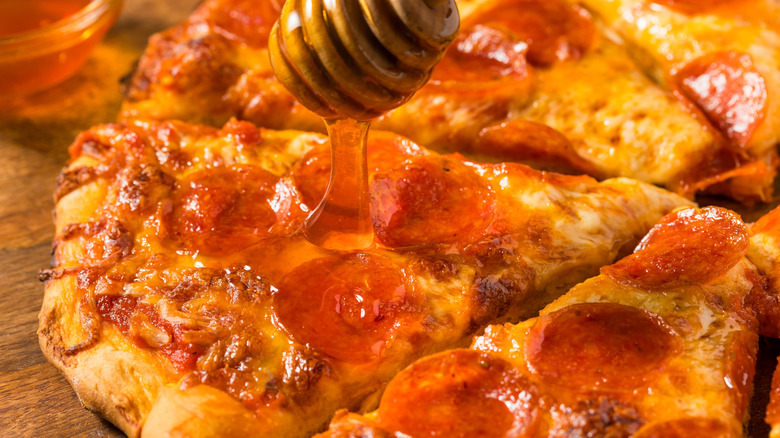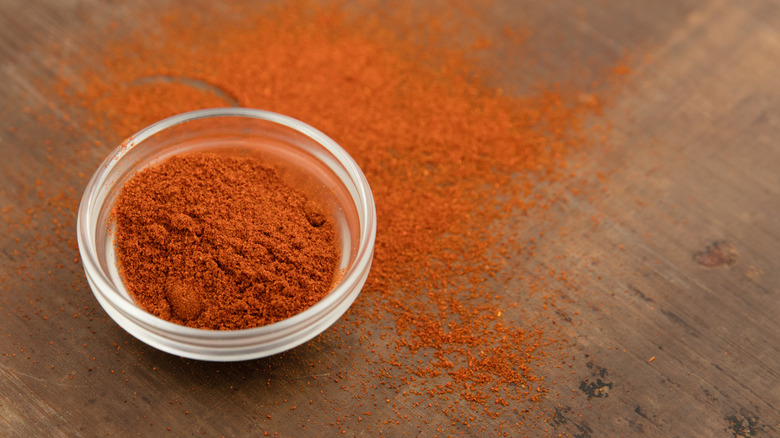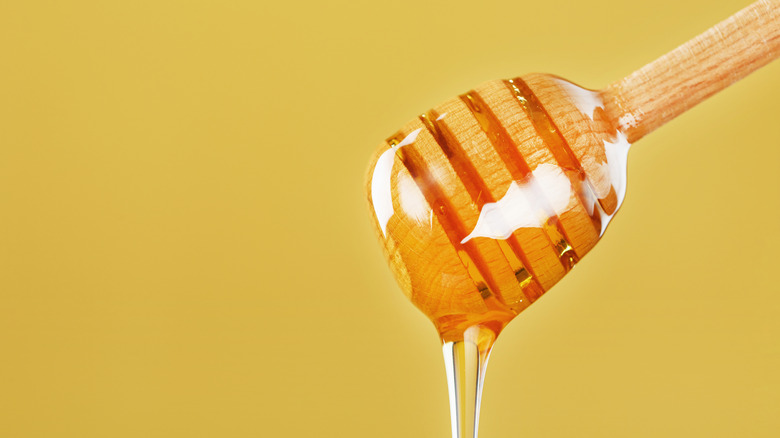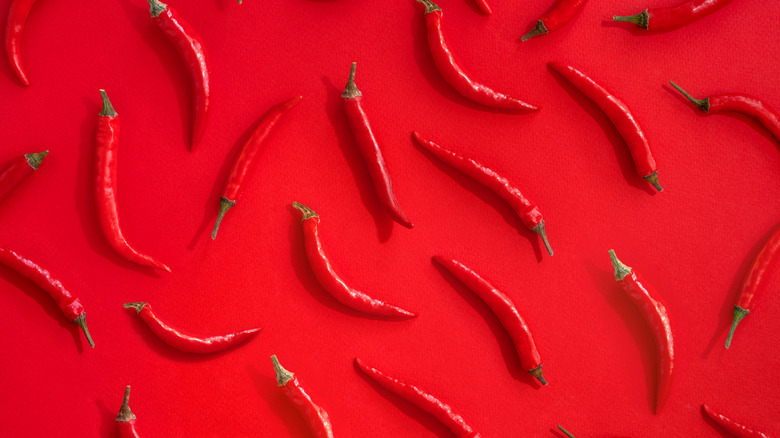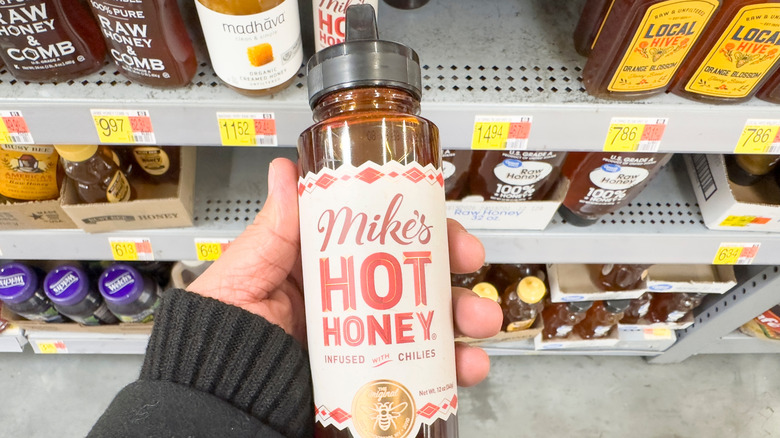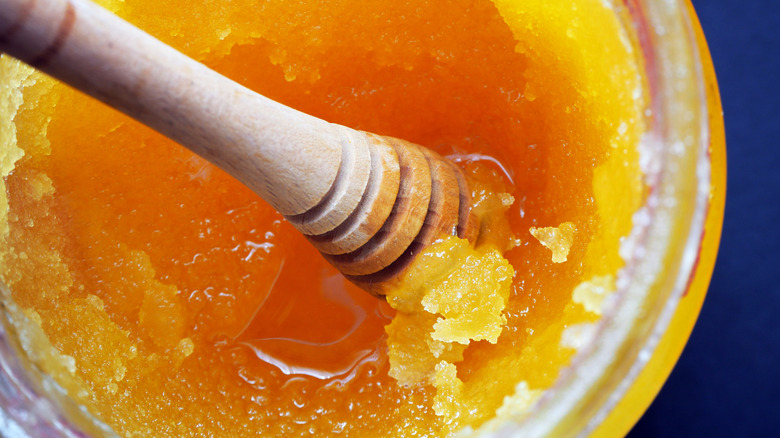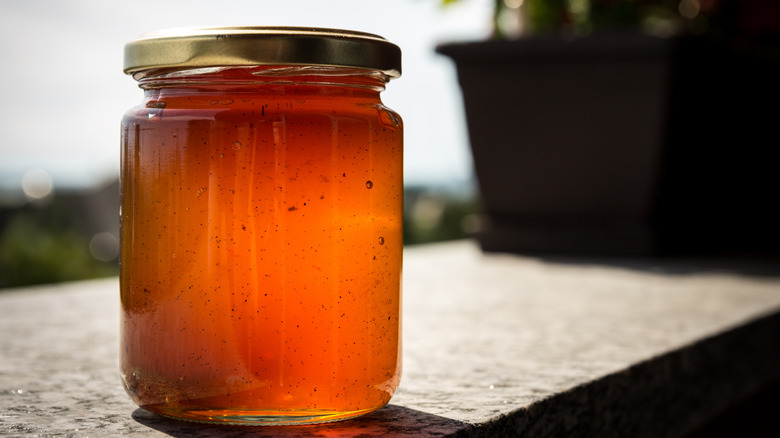The Ultimate Guide To Hot Honey
We may receive a commission on purchases made from links.
Hot honey is everywhere. The condiment that people are dying to try isn't exactly new, but in recent years it feels like it's come into its own, with everyone from Wendy's including it in its sandwiches to Dunkin' teaming up with hot honey brands. Honestly, though, we're kinda surprised it's taken people this long to realize how delicious hot honey is. The perfect balance of sweet and spicy, hot honey provides any meal with a double-punch of flavor, and a drizzle of the piquant sauce can complement both savory and sweet menu items with its innovative profile.
As with any culinary sensation that takes the world by storm, though, it's natural to want to get to the bottom of what this fiery honey actually is — and where it came from. Is it the brainchild of a single food trailblazer, or does it have more established roots? Is making it really just as simple as combining chilies with honey and hoping for the best? Plus, if you're not making it, what's the best hot honey brand to go for, and how do you use it once it's in your kitchen? With our one-stop-shop guide to hot honey, you'll never be wondering any of these things again.
What is hot honey?
First things first: Is hot honey really what it sounds like? In short, yes. Hot honey is, in its simplest form, a combination of honey and a heat source – usually fresh chilies or chili flakes, although it may also generate its fieriness from the addition of hot sauce. That's ... Kinda it, folks. If that sounds too simple, though, that simplicity is what's behind the appeal of this condiment.
By keeping recipes to just the basic ingredients, you allow the heat of the chilies and the sweetness of the honey shine in full, and simultaneously prevent them from being too intrusive: Instead of overpowering your food, it works as a complement to whatever you're smothering it on. Having said this, more complicated versions of hot honey may also have additional ingredients, with vinegar or lime juice being a common addition or a pinch of salt being used to intensify the main flavors. Some folks also mix in additional seasonings or spices to give it a little more complexity and depth.
What are the origins of hot honey?
Because hot honey's so popular nowadays, it's easy to assume that it must be a new invention. After all, if it was more than a few years old, then surely we'd have been using it our whole lives, right? Well, the truth is that forms of hot honey have been around for longer than we think. The mixing of sweet syrups like honey and spices is a practice that's appeared time and time again throughout history, popping up in ancient China as well as Medieval-era Europe and Northern Africa. The predecessor that has the closest link to hot honey as we now know it, though, is "pepperoncini honey," an Italian infusion of peppers and honey that's been around for centuries.
The existence of Italian pepperoncini honey also hints towards the most established use of hot honey today, which is to put it on pizza. That's something that food entrepreneur Mike Kurtz discovered when he was on a trip to Brazil and encountered a chili-infused honey in a pizzeria. When Kurtz came back to the United States, he started perfecting his version of hot honey, selling it in his own pizza place – and things soon took off. Soon, Mike's Hot Honey was making waves in the American food scene, and hot honey began to grow in popularity nationwide before becoming the culinary giant we know it as today.
Why is hot honey so popular all of the sudden?
Hot honey's popularity in the United States, and indeed around the world, has been largely driven by the success of the Mike's Hot Honey brand. However, it's a little more complicated than that. While Mike's Hot Honey has gradually been growing in size over the past decade or so, things really took off when social media started to take note of the flavor combination. Once influencers and general users alike caught wind of hot honey, things exploded online, with the #hothoney hashtag generating well over 900 million engagements on TikTok, and Google searches of the condiment skyrocketing.
With the increased attention on hot honey, mainstream companies started to take note, with more and more businesses fighting to include it in their output, sell it in their stores, or collaborate with Mike's Hot Honey itself. As you can expect, this led to a gold rush on the making of the product. Nowadays, there are plenty of hot honey brands out there vying for people's attention, with some of them seeing a tenfold increase in growth in just 12 months as everyone fights to stock their shelves with the condiment. This has been facilitated by the inability of Mike's Hot Honey to trademark the recipe and flavor combo, which has opened the doors for other people to get involved.
What types of hot honey are available?
Hot honey thrives on simplicity, and the temptation to fuss around with its flavors will only result in disappointment. Having said this, though, there's likely more variety to be found than you think. Both of the two main ingredients in hot honey, chilies and honey, come in a range of varieties — and changing them up will result in different flavor profiles. Making hot honey with cayenne chili peppers, for instance, will result in a deep, slightly fruity flavor and a slow-developing heat. Conversely, going for scotch bonnet peppers will make your hot honey intensely spicy and fiery, with their gentle hint of sweetness playing very well with the syrupy tones of the honey.
The question of which honey you use will be answered by how deep and rich you want your hot honey to be. Most hot honeys use light varieties, which have floral flavor notes and scents and an immediate sweetness, as well as an easily pourable consistency. However, if you use manuka or buckwheat honey, you'll get a more treacly result, with these darker varieties having a slightly more caramelized taste and a slightly creamier texture. Ultimately, though, you don't want one flavor element to dominate here, so don't be tempted to go for an ultra-strong honey or peppers that are way too spicy.
What is the nutritional content of hot honey?
We don't think enough about the nutrition in our condiments, folks. With something like hot honey, you kinda need to though. This delicious drizzle can make an impact with just a small amount, but if you really want your food to pop you don't wanna skimp on things. As such, it's important to know what's in it — and the answer is a whole lotta sugar. It's likely no surprise, but hot honey is basically pure carbs. In 1 tablespoon of Mike's Hot Honey there are 18 grams of carbohydrates, with 14 of those grams being composed of sugar. It also comes in at 72 calories per tablespoon. Plus, other hot honey brands may have added ingredients like salt or other flavor enhancers that change up their nutrition even further.
Having said this, it's also important to remember that there are some benefits to eating hot honey over more basic or processed sweeteners. Honey is well known for having antioxidants in it, and these antioxidants could have protective benefits for your heart health. They might also make it a more beneficial sweetener if you're trying to keep your blood sugar in check. It's worth remembering, though, that these benefits are only really true for honey that's only been lightly processed. If you're buying cheaper varieties of hot honey that use low-quality honey, they may not have the same antioxidant levels as raw honey.
What dishes and drinks can you make with hot honey?
When it comes to using hot honey, the possibilities are kinda endless. This condiment is most commonly used as a pizza topping or drizzled onto fried chicken, where its sweet spiciness somewhat tempers the salty, fatty notes of these foods. However, it's just at home on healthier dishes and can be used to make a sweet, hot salad when incorporated into your dressing.
Hot honey is also excellent when incorporated into snack foods. Next time you make some gourmet popcorn, spoon over some hot honey. The relatively neutral flavor of the corn will allow the spicy honey to shine, while the corn's gentle nuttiness will help to moderate the honey's heat and sweetness. The condiment can also be used to season homemade potato chips or as a component in spiced nuts.
Plus, who said that you can only use hot honey in your food? It's also an excellent addition to drinks, where its sweet heat infuses and adds ridiculously delicious layers of flavor. Next time you make a spicy margarita, incorporate some hot honey and watch your guests go wild. For a slightly less alcoholic, but no less punchy beverage, pour a tablespoon of hot honey into some lemon and ginger tea. We guarantee that it'll soothe you, while also tickling your tastebuds.
How do you make hot honey?
Although there are plenty of places to buy hot honey these days, making it at home is a breeze. You simply need to pour honey into a pan, and then add freshly chopped chilies or chili flakes. For every cup of honey, you should add about 2 tablespoons of chili flakes or one to three chili peppers, although you can of course add more or less depending on how spicy you like things. The ingredients are cooked together briefly before being left to infuse, and the chilies or chili flakes are then strained out, leaving a smooth, punchy sauce.
However, using chilies or chili flakes isn't the only way to make it. Making homemade hot honey with hot sauce is a good way to add intense heat while also incorporating vinegary notes, and you also get the added advantage of not having to cook the two together. If you're using hot sauce, it's generally best to opt for a thinner, fairly tart variety. For a totally different type of heat, you can also make hot honey with gochujang, again by simply mixing the two together. Bear in mind that this can produce a hot honey that's pretty thick, so you may want to thin things out with some water.
What's the best store-bought hot honey?
We're pretty spoiled for choice when it comes to store-bought hot honey, and nowadays supermarket shelves are bulging with different brands. As this condiment can be fairly pricey, though, you want to make sure you're making the right choice. While you can't go wrong with Mike's Hot Honey, the classic version may not be the best kind out there, as it can be fairly innocuous and not make that much of an impact on stronger-tasting dishes. We prefer Mike's Hot Honey Extra Hot, which has a seriously punchy flavor and doesn't hold back on the spice.
Stepping away from the Mike's brand, Bushwick Kitchen's Bees Knees Spicy Honey is also a superb choice, with a slowly-developing heat and a deep sweetness that makes this sauce a real event. Trader Joe's Organic Spicy Hot Honey Sauce is also a great store-brand option, with a citrusy pop that cuts through the heat and sweetness. If you're lucky enough to find it, Aldi's hot honey is not only very spicy but very reasonably priced. Be warned, though: You may have to be prepared to scour the shelves of a few stores, as there's no telling what Aldi will have in stock.
What to do if your hot honey crystallizes
Hot honey, like other types of honey, can end up crystallizing if you're not careful. Crystallization occurs naturally over time when it sits in your pantry, as the glucose molecules in the liquid pull away from the water. As they do this, they turn into small crystals, which are just as tasty but which obviously don't have the runny consistency that you expect.
It's important to note that crystallized hot honey hasn't gone bad in any way, but it makes it harder to use. Luckily, you can quickly turn it back into liquid. The easiest way to do this is to place your bottle of hot honey in a sous vide or a warm water bath and gently heat it to about 110 degrees F. You'll want to be careful with this, as some plastic bottles can melt if the water's any hotter, and glass jars can crack if you plunge them into ultra-hot water. If you're worried about this, spooning the crystallized honey into a heatproof Ziploc bag and putting it in warm water can be a good move. Don't be tempted to microwave your hot honey bottle, as this may cause it to overheat and melt.
How to store hot honey
You can store hot honey in the same way that you store regular honey: in your pantry. Honey doesn't go bad, and unless you've included a load of rogue ingredients in it, there's no reason why it should either — so there's no need to put it in the fridge. Furthermore, putting hot honey in the fridge can cause it to crystallize, which will leave you with an annoying job to liquify it further down the line. It's best to keep it in a pantry in a room that's normally above 70 degrees F.
While you can keep hot honey for a good length of time, it's worth pointing out that while it may not necessarily go bad, its flavor might deteriorate the longer it's kept. As such, you should use homemade hot honey within three months to get the best taste. Store-bought hot honeys might have a longer expiration date, but you should taste-test them periodically to ensure that things haven't deteriorated. Like regular honey, you can also freeze hot honey if you're so inclined. We'd argue that's generally not necessary though, unless you're planning on making a batch to use years down the line.
